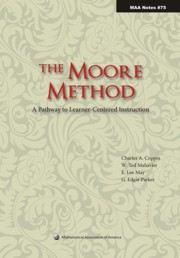Book contents
- Frontmatter
- Contents
- Dedication
- Acknowledgements
- 1 Introduction
- 2 Moore's Moore Method
- 3 What is the Moore Method?
- 4 On Culture
- 5 Development and Selection of Materials
- 6 In the Classroom
- 7 Grading
- 8 Why Use the Moore Method?
- 9 Evaluation and Assessment: Effectiveness of the Method
- 10 Frequently Asked Questions
- Appendices
- About the Authors
- References
- Index
4 - On Culture
- Frontmatter
- Contents
- Dedication
- Acknowledgements
- 1 Introduction
- 2 Moore's Moore Method
- 3 What is the Moore Method?
- 4 On Culture
- 5 Development and Selection of Materials
- 6 In the Classroom
- 7 Grading
- 8 Why Use the Moore Method?
- 9 Evaluation and Assessment: Effectiveness of the Method
- 10 Frequently Asked Questions
- Appendices
- About the Authors
- References
- Index
Summary
“We have to believe—before students can believe—that hard work pays off, that effort matters, that success depends not on your genes but on your sweat. We must convince students that they can do it when they have teachers who insist on quality work and give them extra remedial help when needed.”
Gene Bottoms, Director, High Schools that WorkWe address the culture in the classroom before addressing the mechanics of the method, for we believe that the mechanics have the best chance for success within a classroom of appropriate culture. As our method of instruction will likely be radically different from that to which our students are accustomed and will likely place more responsibility for active learning on them, part of the established culture is to provide some justification to the students as to how this approach can enhance their intellectual growth. By the same reasoning, we need to provide an environment that has the capacity to maximize the success of each student. The culture should emphasize student responsibility for learning and creating mathematics, while reducing the need for the exercise of authority by the instructor. We strive for a low stress environment and a relaxed atmosphere within the classroom because we are asking students to produce, present, and defend the mathematics of the course. Demonstrating and defending such a personal product can be stressful even in a friendly environment. Who hasn't had butterflies before his or her own research talks at conferences?
- Type
- Chapter
- Information
- The Moore MethodA Pathway to Learner-Centered Instruction, pp. 29 - 44Publisher: Mathematical Association of AmericaPrint publication year: 2009

